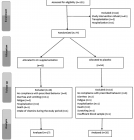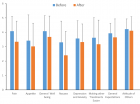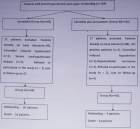Abstract
Research Article
Study on the Molecular Mechanism of Antioxidant Health Effect of Tuna Dark Meat Enzymatic Polypeptides
Zhang Diya, Dong Xin* and Guo Chunyu
Published: 21 March, 2024 | Volume 8 - Issue 1 | Pages: 011-015
In order to study the molecular mechanism of the antioxidant effect of enzymatically hydrolyzed tuna dark meat peptides, this article uses alkaline protease to enzymatically hydrolyze tuna dark meat, and at the same time performs peptide sequencing using matrix-assisted laser dissociation time-of-flight mass spectrometry (MALDI TOF/TOF). Discovery Studio (DS) performed molecular docking. Finally, the antioxidant effect was verified through DPPH clearance experiments. The results show that the dominant peptide sequences in the tuna dark meat hydrolyzed polypeptides are LAPGQ, GGGDPI, and PLRLP; through molecular simulation methods (Discover Studio, DS), the potential target of the above-mentioned enzymatic polypeptides was screened out to be Keap1, thus predicting antioxidant activity. It provides theoretical support for further research on enzymatic peptides. Through DPPH clearance experiments, it was found that both the enzymatic hydrolysate and LAPGQ, GGGDPI, and PLRLP have antioxidant activity, confirming their effects.
Read Full Article HTML DOI: 10.29328/journal.ascr.1001078 Cite this Article Read Full Article PDF
Keywords:
Tuna by-products; Enzymatic peptides; Molecular docking
References
- Herpandi NH, Rosma A, Nadiah WAW. The tuna fishing industry: a new outlook on fish protein hydrolysates. Comprehensive Reviews in Food Science & Food Safety. 2011; 10(4): 195-207.
- Sohn JH, Ohshima T. Control of lipid oxidation and meat color deterioration in skipjack tuna muscle during ice storage. Fisheries Science. 2010; 76(4): 703-710.
- Su Y. Analysis of Nutrient Composition and Study on Anti fatigue Activity of Muscle Protease Hydrolysates of Three Tuna Species from the South China Sea. Guangdong: Guangdong Ocean University, 2015.
- Su Y, Zhang C H, Cao WH. Analysis and Evaluation of Nutritional Composition of Three Kinds of Tuna Common Meat and Dark Meat Produced in the South China Sea [J] Journal of Guangdong Ocean University. 2015; 35(3):87-93.
- Je JY, Qian ZJ, Byun HG. Purification and characterization of an antioxidant peptide obtained from tuna backbone protein by enzymatic hydrolysis. Process Biochemistry. 2007; 42(5): 840-846.
- Je JY, Lee KH, Mi HL. Antioxidant and antihypertensive protein hydrolysates produced from tuna liver by enzymatic hydrolysis. Food Research International. 2009; 42(9): 1266-1272.
- Liu JH, Wang B, Kuai P. Enzymatic hydrolysis process of dark tuna meat and nutritional value evaluation of its hydrolysates. Food Science. 2014; 35(20): 1-5.
- Han J, Tang S, Li Y. In silico analysis and in vivo tests of the tuna dark muscle hydrolysate anti-oxidation effect. Rsc Advances. 2018; 8(25): 14109-14119.
- Xin J M, Wang P, Li S H. A Study on the Technology of Compound Enzymatic Hydrolysis of Broken Tuna Meat. The Food Industry. 2011(9); 25-28.
- Qian ZJ, Je JY, Kim SK. Antihypertensive effect of angiotensin i converting enzyme-inhibitory peptide from hydrolysates of Bigeye tuna dark muscle, Thunnus obesus. J Agric Food Chem. 2007 Oct 17;55(21):8398-403. doi: 10.1021/jf0710635. Epub 2007 Sep 26. PMID: 17894458.
- Hsu KC. Purification of antioxidative peptides prepared from enzymatic hydrolysates of tuna dark muscle by-product. Food Chemistry. 2010; 122(1): 42-48.
- Park K, Cho AE. Using reverse docking to identify potential targets for ginsenosides. Journal of Ginseng Research.
- Grienke U, Kaserer T, Pfluger F, Mair CE, Langer T, Schuster D, Rollinger JM. Accessing biological actions of Ganoderma secondary metabolites by in silico profiling. Phytochemistry. 2015 Jun;114:114-24. doi: 10.1016/j.phytochem.2014.10.010. Epub 2014 Nov 6. PMID: 25457486; PMCID: PMC4948669.
- Xie CL, Chong SY, Cao GP, In silico investigation of action mechanism of four novel angiotensin-I converting enzyme inhibitory peptides modified with Trp. Journal of Functional Foods. 2015; 17: 632-639.
- Tu M, Wang C, Chen C, Zhang R, Liu H, Lu W, Jiang L, Du M. Identification of a novel ACE-inhibitory peptide from casein and evaluation of the inhibitory mechanisms. Food Chem. 2018 Aug 1;256:98-104. doi: 10.1016/j.foodchem.2018.02.107. Epub 2018 Feb 21. PMID: 29606478.
- Gao B, Doan A, Hybertson BM. The clinical potential of influencing Nrf2 signaling in degenerative and immunological disorders. Clin Pharmacol. 2014 Feb 3;6:19-34. doi: 10.2147/CPAA.S35078. PMID: 24520207; PMCID: PMC3917919.
- Hu LF, Wang Y, Ren RJ. The antioxidant stress effect and regulatory mechanism of Keap1-Nrf2/ARE signaling pathway [J] International Journal of Pharmaceutical Research. 2016; 43(1): 146-152.
- Huerta C, Jiang X, Trevino I, Bender CF, Ferguson DA, Probst B, Swinger KK, Stoll VS, Thomas PJ, Dulubova I, Visnick M, Wigley WC. Characterization of novel small-molecule NRF2 activators: Structural and biochemical validation of stereospecific KEAP1 binding. Biochim Biophys Acta. 2016 Nov;1860(11 Pt A):2537-2552. doi: 10.1016/j.bbagen.2016.07.026. Epub 2016 Jul 27. PMID: 27474998.
Figures:
Similar Articles
-
Study on the Molecular Mechanism of Antioxidant Health Effect of Tuna Dark Meat Enzymatic PolypeptidesZhang Diya, Dong Xin*, Guo Chunyu. Study on the Molecular Mechanism of Antioxidant Health Effect of Tuna Dark Meat Enzymatic Polypeptides. . 2024 doi: 10.29328/journal.ascr.1001078; 8: 011-015
Recently Viewed
-
Leiomyosarcoma in pregnancy: Incidental finding during routine caesarean sectionToon Wen Tang*,Phoon Wai Leng Jessie. Leiomyosarcoma in pregnancy: Incidental finding during routine caesarean section. Clin J Obstet Gynecol. 2021: doi: 10.29328/journal.cjog.1001094; 4: 092-095
-
Adult Neurogenesis: A Review of Current Perspectives and Implications for Neuroscience ResearchAlex, Gideon S*,Olanrewaju Oluwaseun Oke,Joy Wilberforce Ekokojde,Tolulope Judah Gbayisomore,Martina C. Anene-Ogbe,Farounbi Glory,Joshua Ayodele Yusuf. Adult Neurogenesis: A Review of Current Perspectives and Implications for Neuroscience Research. J Neurosci Neurol Disord. 2024: doi: 10.29328/journal.jnnd.1001102; 8: 106-114
-
Late discover of a traumatic cardiac injury: Case reportBenlafqih C,Bouhdadi H*,Bakkali A,Rhissassi J,Sayah R,Laaroussi M. Late discover of a traumatic cardiac injury: Case report. J Cardiol Cardiovasc Med. 2019: doi: 10.29328/journal.jccm.1001048; 4: 100-102
-
A two-phase sonographic study among women with infertility who first had normal sonographic findingsKalu Ochie*,Abraham John C. A two-phase sonographic study among women with infertility who first had normal sonographic findings. Clin J Obstet Gynecol. 2022: doi: 10.29328/journal.cjog.1001117; 5: 101-103
-
Sinonasal Myxoma Extending into the Orbit in a 4-Year Old: A Case PresentationJulian A Purrinos*, Ramzi Younis. Sinonasal Myxoma Extending into the Orbit in a 4-Year Old: A Case Presentation. Arch Case Rep. 2024: doi: 10.29328/journal.acr.1001099; 8: 075-077
Most Viewed
-
Evaluation of Biostimulants Based on Recovered Protein Hydrolysates from Animal By-products as Plant Growth EnhancersH Pérez-Aguilar*, M Lacruz-Asaro, F Arán-Ais. Evaluation of Biostimulants Based on Recovered Protein Hydrolysates from Animal By-products as Plant Growth Enhancers. J Plant Sci Phytopathol. 2023 doi: 10.29328/journal.jpsp.1001104; 7: 042-047
-
Sinonasal Myxoma Extending into the Orbit in a 4-Year Old: A Case PresentationJulian A Purrinos*, Ramzi Younis. Sinonasal Myxoma Extending into the Orbit in a 4-Year Old: A Case Presentation. Arch Case Rep. 2024 doi: 10.29328/journal.acr.1001099; 8: 075-077
-
Feasibility study of magnetic sensing for detecting single-neuron action potentialsDenis Tonini,Kai Wu,Renata Saha,Jian-Ping Wang*. Feasibility study of magnetic sensing for detecting single-neuron action potentials. Ann Biomed Sci Eng. 2022 doi: 10.29328/journal.abse.1001018; 6: 019-029
-
Pediatric Dysgerminoma: Unveiling a Rare Ovarian TumorFaten Limaiem*, Khalil Saffar, Ahmed Halouani. Pediatric Dysgerminoma: Unveiling a Rare Ovarian Tumor. Arch Case Rep. 2024 doi: 10.29328/journal.acr.1001087; 8: 010-013
-
Physical activity can change the physiological and psychological circumstances during COVID-19 pandemic: A narrative reviewKhashayar Maroufi*. Physical activity can change the physiological and psychological circumstances during COVID-19 pandemic: A narrative review. J Sports Med Ther. 2021 doi: 10.29328/journal.jsmt.1001051; 6: 001-007

HSPI: We're glad you're here. Please click "create a new Query" if you are a new visitor to our website and need further information from us.
If you are already a member of our network and need to keep track of any developments regarding a question you have already submitted, click "take me to my Query."
















































































































































